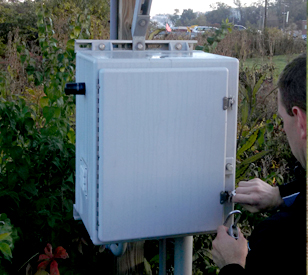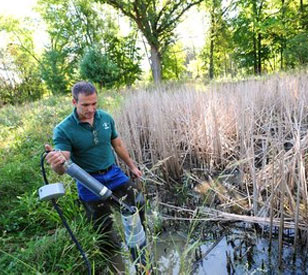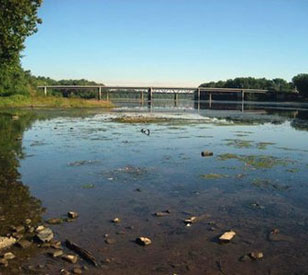Stream and River Monitoring

Streams and rivers are the major arteries transporting the earth’s freshwater. Many of the world’s great cities are located along large streams and rivers, and these waters serve many important functions including habitat for fish and other aquatic life, nutrient transport, drinking water, industrial water supply, irrigation, transportation, power generation and recreation. Protecting the health of these waterways is essential in maintaining the balance between nature and human civilization.
Stream and Rivers Water Quality

Typical Stream and River Water Quality System
Stream gage systems like those operated by the USGS provide valuable oversight of flow conditions and water quality in streams and rivers. When properly installed and maintained, these systems can deliver many years of useful data.
NexSens stream and river water quality systems typically monitor water level with a pressure transducer or non-contact level sensor and various water quality parameters with a multisensor sonde. Instruments such as those from YSI, Hydrolab, Eureka and In-situ are compatible with the NexSens X3 environmental data logger and can measure temperature, pH, conductivity, dissolved oxygen, turbidity, nutrients, algae, chlorophyll and more. Water level data may be used to estimate flow rates if the river or stream cross section is known.
Water quality sensors are often installed in a perforated deployment pipe securely mounted on the bank of the river or stream. Sensors may be secured at a fixed position within the pipe and easily removed from the water for maintenance and calibration.
The X3 data logger is mounted on a nearby structure, tree or mast and transmits data wirelessly in near real-time via 4G LTE cellular or satellite communications to the WQData LIVE web datacenter. In a basic configuration, this free service allows users to securely access and analyze data, as well as share data through an API or auto-report. Subscription-based tiers of WQData LIVE are also available for advanced reporting, alarming, and data management including a public portal option.
Multiple sensor ports on the X3 logger accommodate situations where sensors are placed at multiple locations or the system is expanded with other instruments. Tipping bucket rain gauges, multiparameter weather stations, and side-looking current profilers are some of the instruments commonly integrated into stream gage systems.
Contact a NexSens Applications Engineer today to discuss your stream or river monitoring application.

Case Studies
Lake Erie Tributary Monitoring
The western basin of Lake Erie gets a lot of attention thanks to its role in large algal blooms, but it is not the only part of the lake affected by nutrient runoff. And there are organizations all around Lake Erie that work to manage runoff going into different basins of the lake. One of those is the Northeast Ohio Regional Sewer District, which maintains multiple water quality monitoring stations along creeks and rivers that flow into Lake Erie’s waters near Cleveland. These waters cover mostly the lake’s central basin.
Read MoreWetland and Urban Stream Monitoring
Heavy urban development has caused excess stormwater runoff in the Cleveland area. As a result, the city’s metroparks can experience flash floods, which damage aquatic habitat, erode river banks, and carry sediment into Lake Erie. This increased stormwater runoff has had a number of undesirable effects on the parks system and overall watershed health. Under normal circumstances, headwaters moderate flow from heavy rains, process nutrients, and reduce sediment. They also provide habitat for unique native flora and fauna in the water and in surrounding riparian habitats. With heavier runoff, however, they are subject to channelization, culverting, and pollution.
Read MoreSusquehanna River Monitoring
The Susquehanna River is the longest river on the American east coast. It flows from upstate New York and western Pennsylvania for over 440 miles before entering the Chesapeake Bay. It is considered one of the oldest river systems in the world. The Susquehanna has been subjected to various forms of pollution, including agricultural runoff, urban stormwater runoff, and raw sewage. The U.S. government has pushed for the cleanup of the river and proper monitoring of water quality.
Read More







